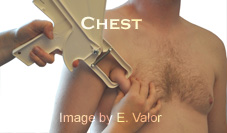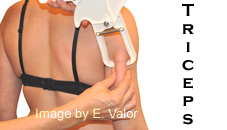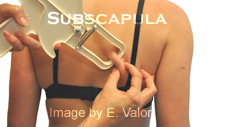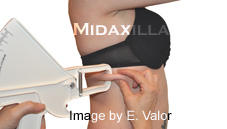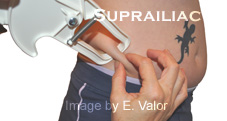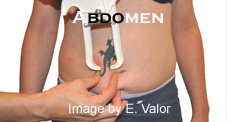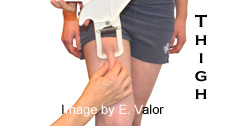The notion that the less fat you have = the healthier you are (and the better looking you are) is not uncommon, but quite wrong. Whilst most people in the Western world could do with losing a few pounds of fat, many people obsess about trying to continuously lose weight, which can be disastrous for health. They obsess about it, and it can lead to developing eating disorders. Truth is, your body needs a certain amount of fat to be healthy (this is called essential fat), and a certain amount of fat is needed for a desirable physique. Here, I’ll explain the healthy amount of body fat for men and women, and how to calculate your own body fat.
The ideal % of body fat
Men and women are very different, both in their requirements of body fat, and how it is stored. So, the ideal/ healthy amount of body fat will be different for the genders. So, I’ll start with the men.
The image on the right gives a rough guide for how the male body looks at various body fat percentages, and the optimal body fat for males lies between the 10%-15%, with body fat closer to the 10% mark
providing a much more athletic look with greater muscle definition.
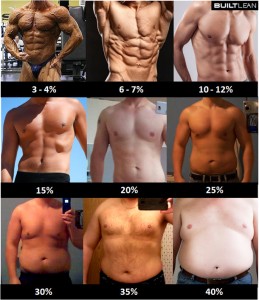 Anything below the 10% mark is considered quite unhealthy, and isn’t sustainable for prolonged periods of time. This kind of body fat is only really achieved by professional bodybuilders for their show. Staying at a body fat level lower than 7% negatively impacts your entire body. Some of the problems you can expect to experience are cardiac problems, weakened immune system and weak your bones1, and can also cause all sorts of emotional and mental strains on you.
Anything below the 10% mark is considered quite unhealthy, and isn’t sustainable for prolonged periods of time. This kind of body fat is only really achieved by professional bodybuilders for their show. Staying at a body fat level lower than 7% negatively impacts your entire body. Some of the problems you can expect to experience are cardiac problems, weakened immune system and weak your bones1, and can also cause all sorts of emotional and mental strains on you.
Anything above 15%, and you start to lose the desirable muscle definition, and abdominal fat starts to show. As body fat percentage increases beyond this point, the risk of developing a number of diseases such as cardiovascular disease2 and type 2 diabetes3 greatly increases.
So, for aesthetic reasons and health reasons, around 12% body fat is healthy for men.
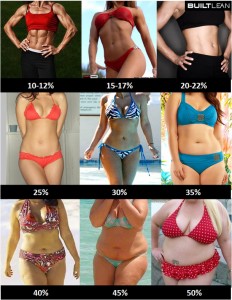 Women will have a higher body fat percentage than a man (and lower muscle mass); this is completely natural, normal and is healthy. In fact, 10-13% body fat is considered to be essential for
Women will have a higher body fat percentage than a man (and lower muscle mass); this is completely natural, normal and is healthy. In fact, 10-13% body fat is considered to be essential for
women. Looking at the body fat percentage pictures for women will give you a rough idea of how a female body looks at various body fat percentages. With women there are various genetic factors which also influence body shape, but the picture still gives you a good idea of what different fat percentages look like.
Ideally (for health and aesthetics) a woman should aim for a body fat percentage in the region of 22%.
Dropping to the low teens of body fat can cause infertility4, weakened bones, poor cardiac health, and as the body fat percentage gets into the late 20’s, you are at a greater risk of cardiac problems, type 2 diabetes, infertility etc.
So, for aesthetic reasons and health reasons, around 22% body fat is healthy for women.
How to calculate your body fat percentage
Online calculators which just use age, weight and height are a load of rubbish, and do not give you anything like an accurate figure.
Annoyingly, to accurately measure your body fat percentage, you need some technology, but this kind of tech is expensive to use, and isn’t readily available to everyone, so the next best thing is a set of skin fold callipers, which are quite cheap to buy. Callipers aren’t as accurate as the more techy methods, but they do give a good ball park figure of your body fat to work with (if done correctly) and the results are quite consistent (as long as the same person measures each time), making them useful for measuring progress.
How to use skin fold callipers
For the best results, you will need a friend or partner to use the callipers, because some of the skin fold locations can be very hard to measure on your own. When using skin fold callipers, don’t rush the measurements, use a ruler, and take your time (perhaps use a marker pen to mark where to measure). This will give you more accuracy and consistency. To calculate body fat percentage with skin fold callipers, you first must measure the skin fold at 7 locations on the body. For each of the following locations, take the measurement 3 times and take an average.
1. The chest
This measurement is taken diagonally between the armpit and nipple. Measure the distance between the 2, and take the measurement a third of the way from the armpit.
2. The triceps
Measure the distance between the the bony part of your shoulder (NOT the shoulder blade) and the furthest tip of the elbow, then mark the halfway point on the back of your arm. The measurement is a vertical measurement at this point.
3. The shoulder blade
First locate the bottom of the shoulder blade, this can be done by moving the arm back and forth. Once located, relax the arm and and take a diagonal measurement 2cm below the tip of the blade (now you see why you need someone to help).
4. 5th rib
This measurement can either be horizontal or vertical, and is taken on the 5th rib below the armpit.
5. Front hip
This measurement is taken 2cm above the creast of the hip, and at a 45 degree angle away from the body.
This measurement is taken vertically, 2cm from the belly button.
7. The thigh
This is a bit of a trickier measurement to take, and is a vertical measurement halfway up the front of the thigh. This is located by measuring halfway between the top of the keen and the fold above the thigh when the leg is raised. This bit of fat is firmer than other locations, so you might need to pinch a bit harder, and as a result, this is one of the least accurate locations.
Now you’re ready to do the calculations, which can be a bit complicated, so its best to just plug the averages for each skin fold (in mm) into this calculator, along with your gender and weight (in kg).
Take the results with a pinch of salt, as this method isn’t the most accurate. Say you’rer a man who comes out at 17% body fat, I would say you have nothing to worry about. These results are a good few % out usually, so as long as you are happy with how you look, you are all good. If you measure again, and find that you are down to 14% though, great job! The difference of 3% is usually pretty accurate (assuming its the same person measuring), so it does show a good 3% loss of body fat, and also means you are more likely to have a healthy body fat percentage than before.
If you are looking to try and lose body fat take a look at our moving section for some exercise ideas (we try and keep it fun!).
Thats all from me for now, I’ve been talking about/looking at pictures of body fat for long enough. If you’ve got any questions/ comments on this post, pop them in below and I’ll get back to you.
%CODE_FAT%
References
University of Pennsylvania. (-). Body Composition Information and FAQ’s Sheet. Available: http://pennshape.upenn.edu/files/pennshape/Body-Composition-Fact-Sheet.pdf. Last accessed 09/12/2014
2.B Larsson. (1984). Abdominal adipose tissue distribution, obesity, and risk of cardiovascular disease and death: 13 year follow up of participants in the study of men born in 1913. Br Med J. 288 (6428), 1401–1404.
3. Gómez-Ambrosi J. (2011). Body adiposity and type 2 diabetes: increased risk with a high body fat percentage even having a normal BMI. Obesity. 19 (7), 1439-44
4. Frisch RE. (1987). Body fat, menarche, fitness and fertility. Hum Reprod. 2 (6), 521-33.
Images courtesy of builtlean.com and E .Valor

